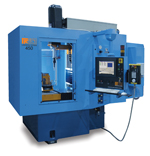22 June 2009
Major turbine manufacturer orders fifth laser drilling system
 Setting the standard for difficult turbine engine cylindrical and shaped hole-making processes, Prima North America Laserdyne Systems announced that its fifth and latest follow-on order from a leading aerospace engine manufacturer incorporates innovative analyzing and reporting functions within the laser drilling processes of these machines.
Setting the standard for difficult turbine engine cylindrical and shaped hole-making processes, Prima North America Laserdyne Systems announced that its fifth and latest follow-on order from a leading aerospace engine manufacturer incorporates innovative analyzing and reporting functions within the laser drilling processes of these machines.
"As turbine engine manufacturers strive to produce engines that are more fuel efficient with fewer emissions, tight control of the laser drilling process is imperative," reports Terry L. VanderWert, company president. "The latest Laserdyne Model 450 incorporates At-Focus-Drilling, Tactile Part Probing and Hole Diameter Compensation software which allow the user to produce parts with extremely close tolerances and with exceptional repeatability. This is made possible with the Laserdyne S94P laser control that includes data logging features which capture key system process parameters, documenting that the manufacturing process is under strict control."
Laserdyne 's latest hardware and software, including the Convergent Laser CL50k (also manufactured by Prima North America), enables the analysis and reporting of laser process information," explains VanderWert. "This provides real-time data logs for all parts manufactured on our systems, something we expect NADCAP to require in the near future."
NADCAP is the leading worldwide cooperative program of major companies designed to manage a cost-effective consensus approach to special processes and products such as laser drilling of aerospace engine components. The stated NADCAP vision is to develop a world-class special processor supply base for the global aerospace industry using a cost-effective industry managed accreditation process.
"The series of follow-on orders by this and other Laserdyne customers demonstrate where the aerospace industry is headed," reports VanderWert. "To further this effort, Laserdyne has been asked to consider installing the CL50k laser to other manufacturer's laser drilling systems which the customer operates. This came about both from the positive evaluation of the CL50k laser and the inability of the competitor lasers to process with equivalent speed, quality and cost effectiveness."
- Contact Information
- Name: Mark Barry
- Email: mbarry@prima-na.com

